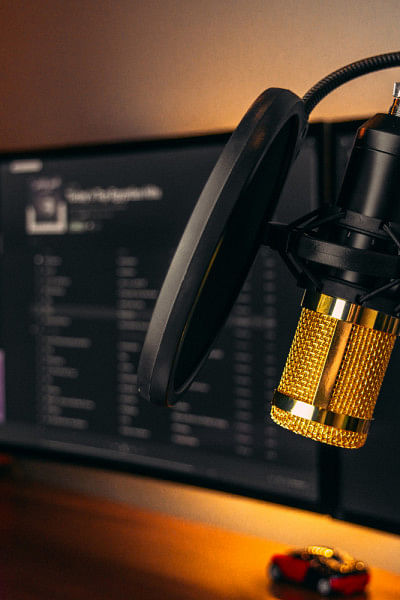Building a podcast studio at home

Step 1: Choose the right space
The first step is to choose the right podcasting space. It is most likely that the location of your podcast studio will have the greatest impact on the sound quality of your audio. If you cannot build your own recording space from scratch, a room in your house will do. Make sure you have a lot of soft surfaces, like carpeting, rugs, and fabric furniture. You should stay away from rooms with hard surfaces, such as your kitchen or the living room. It is also important to pick a space that is not affected by external noise like rooms on the other side of the street or rooms that do not share walls with common areas of your house. It is often great to have a finished basement without sharing walls with other rooms. Despite popular belief, many podcasters record in their closets. It is often easier to get clear audio in small, soft spaces without echoes when there is lots of soft material.
Step 2: Soundproof your podcast studio setup
Next, to add sound treatment, you need to choose a good location. Your recordings will sound better with every step you take to improve their quality. This will save you time later editing the imperfections. The best solution is to use soundproof foam panels. Sound absorbers are used to prevent sound from bouncing around a room or hitting your microphone. You can attach them to blank walls, cabinet faces, or even the ceiling.
Step 3: Grab your recording equipment
A podcast studio setup would not be complete without a few pieces of podcast equipment. However, the amount you buy is entirely up to you. The sound quality on your laptop microphone might not be ideal, but technically you could record episodes with it. We recommend that you grab a few pieces of gear to save you time and hassle when editing your episodes.
Computer
You'll need a computer to run the software that records and edits your episodes. You'll also need it to upload your episodes, write show notes, and market your podcast.
XLR or USB microphone
Your microphone is the most important part of your podcast studio setup. It has the greatest impact on the quality of your audio. A good condenser microphone will save you a lot of time during post-production. An XLR mic and USB microphones each have their advantages and disadvantages.
Mixer
A mixer will improve your audio quality and offer multi-channel recording horse shows with guests or co-hosts. This isn't a required piece of equipment (unless you use an XLR microphone), but it makes amazing audio. Choose one with multiple channels and an AUX-out feature.
Audio Interface
Not all computers have an audio-in port these days. Macs, for example, have not had it for quite some time. To record audio to your computer, connect your mics, and other gear, you will need to use a dedicated audio interface.
Pop filter or windscreen
Good microphones tend to make the plosives in our speech (Ps, Ts, Ks, etc.) stand out, so you need a pop filter to soften those hard bursts of air. These are not expensive, but they make your audio more pleasing.
Headphones
Rather than hearing yourself in the room, you hear what the microphone hears with headphones. In this way, you can control the volume and tone of your recording. Improved records equal less editing (and better records = better records). While you can use any headphones, sets that completely cover your ears (instead of earbuds) are more effective.
Microphone stand
A mic stand or boom mount gets the mic up off the desk and closer to your mouth. This is important because the vertical alignment impacts the sound of your voice. A stand also lessens that chance that you'll bang or rub something against the mic during recording.
Acoustic treatments
Some podcasters work cheaply by covering themselves with a blanket while they record. This technically works, but it gets old fast. Eventually, you'll want to pick up some acoustic treatment pieces that function well and look great in your room.
Step 4: Pick your podcast editing software
Even though it may not be enjoyable to edit their episodes, it's a crucial step in producing good audio. As a podcast studio setup, editing software will come in handy for setting volume levels, removing background noise, and adding intros, outros, and ads. In addition to being free, Audacity has a variety of podcast tools, licensed music, effects, and other features. It's worth the cost because you get all of those effects and features in one tool.
Now you know exactly what you'll need to put together your own podcasting studio. Whether you're planning to spend a few hundred dollars or a few thousand, every penny counts. You'll have a great sounding podcast regardless of your budget. Here's a little secret. Some of the best sounding podcasts out there use much of the more affordable gear featured in this post. The real trick is in good recording and mix-down techniques.

 For all latest news, follow The Daily Star's Google News channel.
For all latest news, follow The Daily Star's Google News channel. 



Comments